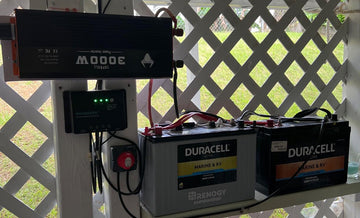Batteries face many challenges during charging and discharging, such as overheating, overcharging, and overdischarging, which not only affect the performance and lifetime of the battery, but may also pose a threat to the safety of the equipment or even the user. In response to these challenges, the battery protection mode has emerged as a safety mechanism built into a battery management system (BMS) or device to protect the battery from damage and ensure safe operation of the device.
What is Battery Protection Mode
Battery protection mode is a safety mechanism built into a battery management system or device to monitor the status of the battery and take action in abnormal situations to prevent damage to the battery or cause a safety incident.
The main purpose of the Battery Protection Mode is to prevent overcharging, over-discharging, short-circuiting and overheating of the battery to ensure the safe operation of the battery and equipment. Through real-time monitoring of the battery's voltage, current and temperature parameters, the protection mode can take timely measures when the battery status is abnormal, such as cutting off the power supply or adjusting the charging and discharging rate, in order to protect the battery from damage.
Battery protection mode works on the basis of the monitoring and control functions of the battery management system (BMS), which monitors battery parameters such as voltage, current and temperature in real time through sensors and compares these data with preset safety thresholds. Once the monitored parameters are out of the safe range, the BMS will immediately trigger the protection mode and take measures such as cutting off the power supply or adjusting the charging and discharging rates to prevent the battery from being damaged or causing a safety accident.
Functions and features of the battery protection mode
Overcharging Protection: Overcharging is when the voltage of a battery exceeds its designed upper limit during charging, which can lead to gassing, expansion or even explosion inside the battery. The battery protection mode prevents overcharging by monitoring the charging voltage and cutting off the power supply when the safe upper limit is reached.
Over-discharge protection: Over-discharge is when the voltage of a battery drops to too low a level during the discharge process, which can lead to a drop in performance, a reduction in capacity or even the inability to recharge the battery. The protection mode prevents over-discharge from occurring by monitoring the discharge voltage and cutting off the power supply when it reaches a safe lower limit.
Short-circuit protection: A short-circuit is a direct contact between the positive and negative terminals of a battery, resulting in excessive current, heating or even explosion of the battery. The protection mode prevents short-circuit by monitoring the battery current and cutting off the power supply when abnormal current is detected.
Temperature Management: Batteries generate heat during the charging and discharging process, and if the temperature is too high or too low it can negatively affect battery performance. The protection mode keeps the battery operating within the appropriate temperature range by monitoring the battery temperature and taking action when a safe threshold is reached, such as adjusting the charge/discharge rate or stopping charging and discharging.
Intelligent Monitoring and Alerting: Some advanced battery protection systems also have intelligent monitoring and alerting features that can monitor the battery status in real time and warn the user of potential problems before they occur.
Which batteries have battery saver mode
Most batteries do not have this basic battery protection, here are some of the battery types that have a battery protection mode:
Lithium-ion batteries (including LiFePO4 lithium batteries):
- Lithium-ion batteries are widely used in portable electronic devices, electric vehicles and energy storage systems.
- These batteries are usually equipped with a built-in battery management system (BMS), which has a battery protection mode that monitors the battery's parameters such as voltage, current and temperature in real time, and takes measures to protect the battery under abnormal conditions, such as cutting off the power supply or adjusting the charging and discharging rates.
Lithium ion deep cycle batteries:
- These batteries also provide battery protection mode, especially suitable for application scenarios that require deep discharge and cycling, such as solar energy storage systems and electric vehicles.
Some high-end lead-acid batteries:
- While conventional lead-acid batteries are not usually equipped with a battery protection mode, some high-end or special-purpose lead-acid batteries may have a similar feature.
- However, the protection of lead-acid batteries usually depends more on external devices and user habits, such as using the right charger and avoiding over-discharge.
It is important to note that not all batteries are equipped with a battery protection mode. Some low-cost batteries or batteries for certain specific applications may not have this feature. Therefore, when selecting a battery, users should carefully check the product description and technical specifications to ensure that the selected battery has the required protection mechanism.
In addition, even if a battery has a protection mode, users should follow proper use and maintenance guidelines to maximise battery life and ensure its safe performance. This includes using the proper charger, avoiding overcharging and discharging, and regularly checking the health of the battery.
What to do if your battery enters battery saver mode
If the device has entered battery protection mode, you can take the following steps to solve the problem:
- Confirm the status: Check the device screen or check the battery status through the relevant apps to confirm the reason for entering the protection mode, such as overcharging, over-discharging or overheating.
- Stop charging or discharging: If it is caused by overcharging, disconnect the charger immediately. If it is due to over-discharge, connect the device to the charger and wait for some time for the battery to recover.
- Keep the device in a suitable temperature environment: If the device is overheating, make sure you place it in a cool and ventilated place, away from direct sunlight or other heat sources.
- Use original charging equipment: Make sure you are using a certified original charger and cable. Non-original accessories may cause unstable charging, which may trigger the protection mode.
- Wait for recovery: Sometimes the battery protection mode will be automatically disengaged after the device has cooled down or adjusted to a safe condition. Let the device sit for a while and see if it can return to normal.
- Check for software updates: Make sure your device's operating system and related applications are up to date. Outdated software may cause the battery management system to not work properly.
- Reboot the device: If the problem persists, try rebooting the device, which may undo some temporary software glitches or errors.
- Contact Technical Support: If the above steps fail to resolve the problem, it is recommended to contact the device manufacturer's customer support or a professional technician for further inspection and repair.
- Avoid prolonged use of the lithium battery in protection mode: In protection mode, the battery may be in a lower performance state and prolonged use may have other effects on the device.
- Regular maintenance: Understand the best usage habits for your battery and regularly check and maintain your battery to avoid recurrence of similar problems in the future.
With these steps, you can effectively deal with the battery protection mode issue and safeguard the normal use of your device and the health of your battery.
Limitations of Battery Protection Mode
While Battery Saver Mode helps extend battery life, there are some limitations:
- Functional limitations that may result: In Battery Saver Mode, the device may not be able to reach its maximum performance output, affecting the usage experience.
- Instances where the protection mode is triggered incorrectly: In some cases, the system may misjudge the battery status, leading to unnecessary interruptions.
- Instances of impacting user experience: Users may not be able to charge or discharge the device immediately due to the battery protection mode, causing inconvenience in use.
Application Scenarios for Battery Saver Mode
Portable electronic devices: In portable electronic devices such as smartphones, tablets, laptops and other portable electronic devices, battery protection mode is critical to extending device life and user safety. By preventing problems such as overcharging, overdischarging and overheating, the protection mode ensures that the device maintains stable performance and safety over a long period of time.
Electric and Hybrid Vehicles: In the field of new energy vehicles, battery protection modes play a key role in ensuring driving safety and the long-term value of the battery. By monitoring the status of the battery in real time and taking appropriate measures, the protection mode can prevent damage to the battery and extend its service life, thus improving the reliability and economy of new energy vehicles.
Energy storage systems: In applications such as home energy storage and industrial backup power, battery protection modes are equally important to ensure system stability and safety. By preventing problems such as overcharging, over-discharging and overheating of the battery, protection modes ensure that the energy storage system provides reliable power support at critical times.
Conclusion
As an important part of the battery management system, the battery protection mode plays an indispensable role in safeguarding battery safety and improving equipment performance. By monitoring the battery status in real time and taking measures in abnormal situations, the protection mode can prevent the battery from being damaged and prolong its service life. At the same time, users should also enhance the knowledge and understanding of the battery protection mode, through rational use and maintenance to jointly promote the sustainable development of battery technology. By working together, we can ensure that batteries play a greater role in a wider range of application scenarios, bringing more convenience and benefits to people's lives and work.













